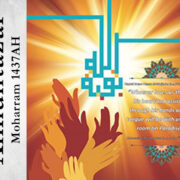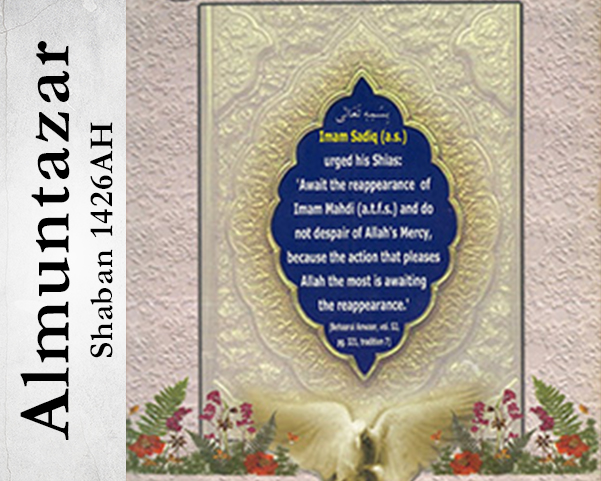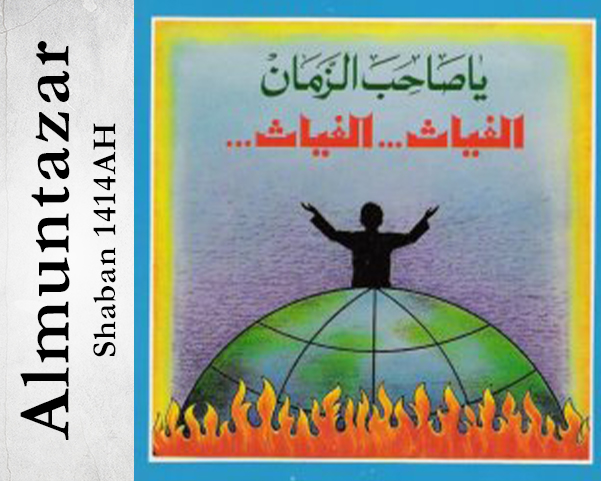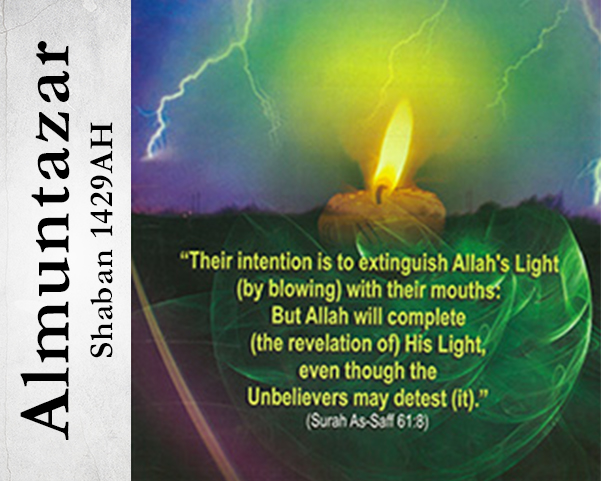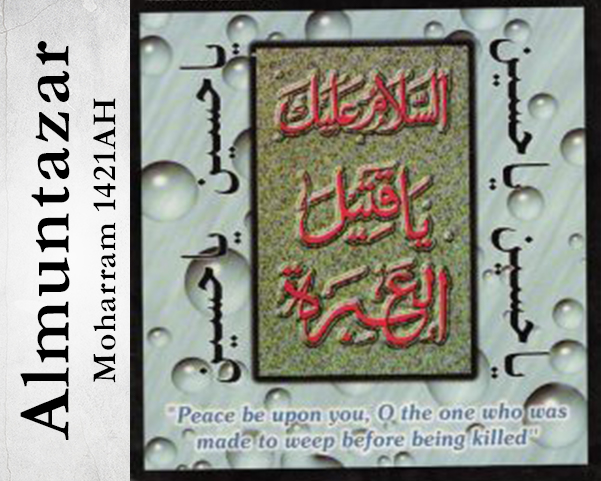Preface
Our infallible Imams (a.s.) are the fountainhead of all material, religious and divine knowledge. Their words and deeds are a source of salvation or us. Following and submitting to them is incumbent upon us and acquiring this religious knowledge has been greatly emphasized. If for a moment, we disregard the teachings of the Imams (a.s.) in favour of worldly gains, then forget salvation of the hereafter, we would be among the losers and misguided ones of this world itself. Our scholars – right from the beginning till date – have rendered selfless service through their efforts and sacrifices in the collection of the treasures of knowledge and for which each and every man of the community remains grateful. This collection is the nations’ wealth, the guarantee of our survival and the provision of the hereafter. This is the right of intercession. The one who is active in this field gets the privilege of rewards. When the flame of the lamp of knowledge lit by the Imams (a.s.) became more luminous through the efforts of these scholars, the hearts of the enemies exploded. The men of evil readied devious weapons and strategies to discredit and disgrace our venerated scholars. They targeted the front ranking scholars and highlighted their shortcomings and weaknesses in order to belittle their importance. These would then be fed into the conversations of the community to promote a vilified environment against them
Something like this happened with Allamah Muhammad Baqir Majlisi (r.a.), whose mind boggling work – the voluminous 110 parts of Behaar al-Anwaar al-Jaameah Le Durare Akhbaar al-Aimmah al-Athaar – and 30 other books will keep his personality alive till the day of Judgement. Especially in the case of Behaar al-Anwaar, whose authenticity and inclusiveness was put under doubt (with malafide intentions) for the seekers of knowledge, researchers and scholars so that they would remain confused in the authenticity of its narrations and explanations.
Some Doubts: A doubt fast gaining prevalence among some scholars and the people leaning towards a scholarly disposition – but not enumerated officially among the Ulama – is that the book (i.e. Behaar al-Anwaar) is a collection of both confirmed and unconfirmed, authenticated and unauthenticated, traditions gathered at a single place. The work of sieving and pruning is on the shoulders of the coming generation of scholars and researchers.
The other doubt spreading amongst scholars is that Behaar al-Anwaar is a collection of traditions, consisting of historical and religious knowledge collected and sorted by the students of Allamah Majlisi (r.a.) while he just lent his name on the cover for its publication after its finalization.
When a brother of Association of Imam Mahdi (a.s.) – who is competent in one field of research and is a skilful student – learnt of this doubt and discussions in the society, he undertook a brief assessment of Allamah’s (r.a.) personality, remarkable works and the opinions of great scholars about this leading persona. He writes:
Behaar al-Anwaar and the author of this immense work Allamah Majlisi (a.r.) do not need any introduction in the Shiite world. The translations of his works are continually published in Urdu and Persian. Allamah Majlisi’s (r.a.) father is also known by the title of Allamah (a very learned scholar) since he was a highly erudite academic. His name was Allamah Muhammad Taqi Ibn Maqsood Ali (r.a.). He is even mentioned as Allamah Majlisi – the first – (Majlisi-e-Awwal) in discussions.
Allamah Majlisi (ar) was born in 1037 A.H in the city of Isfahan. He passed away on the 27th of Ramazan 1110 A.H He was buried in the grand mosque of Isfahan. His grave has visitors even today. (In the new edition of Behaar al-Anwaar, his date of expiry is mentioned as 1111 A.H but this is incorrect). The Seminary of Allamah Majlisi (r.a.) was one of the leading religious schools of Iran and its accomplishments and achievements will be remembered till the Day of Resurrection. The seminary has produced luminaries like Mulla Saleh Mazandaraani and the researcher Amina Khatoon through whom there have been a series of jurisprudents. This was a period of scheming and plotting by the Russian and British powers against the unity and scholastic achievements of Iran. The echoes of the sedition of Ali Muhammad Baab were heard and Prince Dalgorki was ready to enter Iran through the Baab. The center of knowledge was cognizant of the situation and acted as a protective fortification.
His Services
Allamah Majlisi (r.a.) has collected traditions in his book from authentic Shiite sources other than the four main books: Al-Kaafi, Man Laa Yahzorohul Faqih, Istibsaar and Tahzeeb. These four books are the pillars on which rests the Shiite religion.
Hardly has Allamah (r.a.) overlooked any aspect of the Islamic history mentioned by the Sihah and left it unanswered. The first version of Behaar al-Anwaar consisted of 25 volumes so huge that they were subdivided into a 110 volumes for the second edition. This book is a powerful weapon in the hands of our research scholars.
Of the 25 volumes, Allamah (r.a.) has himself provided the explanations and clarifications in 17 volumes, while he did not get an opportunity for the remaining 8 volumes. He made a will to his student Mir Muhammad Husain Khuldabadi (r.a.) to complete this task of exegesis of the remaining traditions. His work is in plain language and easy to understand.
Compilations of Allamah Majlisi (r.a.)
Allah, the High, had bestowed him with great abilities. He was the master of astounding memory and had amazing knowledge. The treasures of knowledge left by the Allamah through his writings and speeches are as follows:
1. Behaar al-Anwaar
2. Hayaah al-Qulub in 3 volumes.
3. Haqq al-Yaqeen
4. Hilyah al-Muttaqeen
5. Ain al-Hayaah
6. Jalaa al-Uyoon
7. Tauheed-e-Mufazzal
8. Jawaabhaa-e-Masaele Mutafarriqah
9. Tazkerah al-Aimmah
And there are innumerable books pertaining to legal rulings. These compilation of books range presently at 58 books but is not a complete summation and there are other writings as well. His work Behaar al-Anwaar has the position of an encyclopedia in all his works.
According to great Islamic scholars, Allamah Majlisi (r.a.) has a position of such prestige that any praise falls short. The very mention of his name is a cause of reverence. The Late Mirza Husain Noori (r.a.), Allamah Waheed Bahbahaani (r.a.), the great teacher – Hajj Sheikh Murtuza Ansari (r.a.) – have not only addressed Allamah Baqir Majlisi (r.a.) as such but have gone on to record about his scholastic capacity, greatness and services and viewed it with admiration. He is respected as a grand researcher, the luminescence of knowledge and a heroic figure.
It is clear to a great extent that the Allamah was close to the fountainhead of divine knowledge and the heir to the teachings of the past Prophets (a.s.), the Imam of the Time (a.s.). Otherwise, the collection of such a vast base of knowledge was impossible for the succeeding generation of researchers. However, Allamah Majlisi (a.r.) did take the help of his students in this endeavor.
Despite the paucity of space, the introduction of Allamah Muhammad Baqir Majlisi (r.a.) was necessary. Our community should be aware of two things. One, they should recognize the scholar who has exposed the baseless arguments of the people concerning religion; and two, the writers and authors should desist from frivolous talk about the Allamah and pay attention to his writings.
The other reason was the introduction of Behaar al-Anwaar inclusive of 25 volumes of which the 13th volume is solely about Hazrat Hujjat Ibn al-Hasan Askari (a.s.).
It is sad that this volume is available only with some scholars. The 13th volume was later subdivided into three: 51st 52nd and the 53rd volumes of the new 110 volumes edition, and the total number of pages spanning the three volumes are 1118. Inshallah, we have the good fortune of taking a peek at all three volumes keeping brevity in consideration.
Imam Mahdi (a.s.) and the 51st, 52nd and 53rd volumes of Behaar al-Anwaar
We present herein for the readers, a divisional preview of the detailed and documentary information regarding Imam Zamana (a.s.) in Behaar al-Anwaar:
The First Chapter:
The birth of Imam Zamana (a.s.) and the conditions of his mother (a.s.) are quoted therein. He has referred to the book Al-Kaafi of Sheikh Kulaini (r.a.) for the date of birth as 15th Shaban 255 AH. Quoting Kamaaluddin, he records that when Janabe Nargis Khatoon (a.s.) became pregnant, Imam Hasan Askari (a.s.) informed her of the birth of a son who would be his successor. The next tradition narrates the incident of Janabe Hakimah Khatoon (s.a.), the paternal aunt of Imam Hasan Askari (a.s.) and the daughter of Imam Muhammad Taqi (a.s.) being present with Janabe Narjis Khatoon (a.s.) at the birth of Imam Zamana (a.s.). Thereafter are the narrations of the aqeeqah of Imam Zamana (a.s.) and his introduction to the select companions of Imam Askari (a.s.) as the heir.
The Second Chapter
The names and titles of Imam Zamana (a.s.) and their appellation have been mentioned. First being about the title Qaem narrated from Imam Baqir (a.s.) that though all the Imams are Qaem bIl Haqq (steadfast on Truth) but the title is specific for Imam Zamana (a.s.) because he will rise for the revenge of the blood of Imam Husain (a.s.).
He is called Mahdi (guided one) because Allah has guided him towards the true affair. He will bring the real Torah and the other divine books to the fore. He will then judge the followers of the Torah according to Torah, the followers of the Bible according to the Bible, the followers of Zaboor according to Zaboor and the Muslims according to Quran.
There is no contradiction in the tradition that the believers of Torah will be judged according to the Torah and the narration that all will follow Islam because Imam (a.s.) will establish the arguments for conforming to Islam from the Torah itself.
The Third Chapter
When and where should the name of Imam (a.s.) be said and when it should be avoided?
The Fourth Chapter
His attributes, signs and lineage. For example, his hidden birth, the family of Ameerul Momineen (a.s.), the reappearance in the last epoch, his appearance of a middle-aged man, his looks, his identification marks and his lineage i.e. he is from the progeny of Imam Reza (a.s.) or Imam Muhammad Baqir (a.s.).
The Fifth Chapter
The mention of verses interpreted by the Ahle Bait (a.s.) as pertaining to the reappearance of Imam Mahdi (a.s.). There are many verses in the Holy Quran that have a hidden meaning different from the apparent meaning and which indicate the appearance of Imam (a.s.).
The Sixth Chapter
The traditions of Allah and His Messenger (s.a.w.a.) concerning Imam Zamana (a.s.) from Shiite and Sunni sources. For example, the narration of the Holy Prophet (s.a.w.a.) that we the children of Abdul Muttalib, the Prophet (s.a.w.a.), Hamza the chief of martyrs, Ja’afar Tayyar, Ali and Fatimah (a.s.), Hasan and Husain (a.s.) and Mahdi (a.s.) are the Chiefs of Paradise.
The Seventh Chapter
The traditions about Imam Zamana (a.s.) narrated from Ameerul Momineen (a.s.).
The Chapters 8-15 contain narrations from Imam Hasan (a.s.), Imam Husain (a.s.), Imam Zainul Abedeen (a.s.), Imam Muhammad Baqir (a.s.), Imam Ja’far Sadiq (a.s.), Imam Moosa Kazim (a.s.), Imam Ali Reza (a.s.), Imam Muhammad Jawad (a.s.), Imam Ali Naqi (a.s.) and Imam Hasan Askari (a.s.) pertaining to Imam Zamana (a.s.).
The Sixteenth Chapter
This chapter contains prophecies of soothsayers like the prophecy of an Arab Christian mystic Sutaih. He was from the Ishaan area of Jordan. The prophecy was made as a reply to the question pertaining to the future events by the king Zajedaan.
The Seventeenth Chapter
The proofs elucidated by Sheikh Toosi (r.a.) concerning Imam Zamana (a.s.) and his occultation.
The Eighteenth Chapter
The proofs of the occultation of Imam Zamana (a.s.) supported by proofs of occultation of the previous Prophets (a.s.).
The Nineteenth Chapter
The replies to the opponents of the longevity of Imam Zamana (a.s.) and the evidences for his longevity and occultation through the mention of the long lives of some people through the ages. This is a lengthy chapter including references of people with long lives taken from the book Kamaaluddin by Sheikh Saduq (r.a.). The people who think long life as impossible have been rejected by use of these examples. References of amazing long ages have also been taken from Sayyed Murtuza (r.a.), Allamah Karajki (r.a.) and Sheikh Mufid (r.a.). It is proven that long life is not a new concept.
The Twentieth Chapter
Some miracles of Imam Zamana (a.s.) and mention of his deputies. Forty two people have been mentioned. Imam Zamana (a.s.) has guided and helped his followers in these incidents. People were in awe as the events unfolded before them.
The Twenty-First Chapter
The special deputies in the minor occultation and communication of Imam Zamana (a.s.) to his Shias through them have been mentioned. Abu Amr Uthman bin Saeed Amri (r.a.), Abu Ja’far Muhammad bin Uthman Amri (r.a.), Abul Qasim Husain bin Rauh Naubakhti (r.a.) and Abul Hasan Ali bin Muhammad Seymouri (r.a.) were the special deputies of Imam Zamana (a.s.). Imam (a.s.) established a perfect system through these deputies as a prelude to the major occultation. Imam (a.s.) stimulated the thought processes of the Shias, how they can keep in touch with the Imam and solve problems.
The Twenty-Second Chapter : The mention of the false claimants
Some people have claimed deputyship in the minor occultation. Abu Muhammad Hasan Sharee’i was the foremost of them. The other claimants include Muhammad bin Nuzair Ghairi, Ahmad bin Helaal Karkhi, Muhammad bin Ali Bilaal, Husain bin Mansoor Hallaj, Muhammad bin Ali Shalmaghaani and Abu Bakr Baghdadi (also known as Abu Dalf the Insane). Allah degraded them all.
There are a total of 10 chapters in the 52nd volume. As we had mentioned in the foreword of the 51st volume, there are five introductory chapters and then the original discussion begins. The volume contains 22 chapters but after deducting the 5 chapters of the beginning, we come to a total of 17 chapters. The chapters of the 51st and 52nd volume constitute a total of 27 chapters.
The Eighteenth Chapter
(That is the 23rd according to the system). It is regarding the persons who saw Imam Zamana (a.s.).
An incident is narrated below:
Narrated from Ali ibn Ibrahim Fadaki, from Awdi – I was circumbulating the Ka’ba. I had completed 6 circumbulations and was going to start the seventh. I saw some people sitting on the right side of Ka’ba. (If you face the door, then the Hajar al-Aswad is on the left and the stone of Ismail is on the right). A handsome and perfumed gentleman came near them and started conversing with them. I too thought of talking with him but the crowd did not allow me through. I asked a person, who is this man? He replied: He is the son of Allah’s Messenger (s.a.w.a.). Every year on a particular day, he meets with some special people and converses with them. I turned towards him and said: ‘I have come to you. Guide me, may Allah guide you!’ He picked a handful of pebbles and gave them to me. I exclaimed: Pebbles! But when I opened my fist, I saw it filled with gold coins. When I moved from there, I saw the Master come towards me and said: ‘The signs of truth are clear for you and the blindness of your heart has been uncovered, do you know me?’ By Allah, I do not know you, I responded.
He said: ‘I am the same Mahdi, the Qaem. I will fill the earth with justice and equity as it will have been filled with injustice and oppression. The world will never remain devoid of the Hujjat of Allah….’
Reminder
Innumerable incidents have been narrated where the Imam has met people in Makka, Madinah, Saamarraa, Qum, Najaf and different locations throughout the world and guided them.
The Nineteenth Chapter (24th Chapter of the old system)
The meeting of Sa’d bin Abdullah Ash’ari with Imam Zamana (a.s.) and the replies given to his numerous queries. Sa’d bin Abdullah displayed a great zeal in collecting books and confirming the truth of Shiite beliefs with their help due to which he would sometimes be involved in debates with the Sunnis. Imam Zamana (a.s.) was of great help to him and so the opponents had to face defeat and humiliation.
Twentieth Chapter (25)
Reason for the occultation of Imam Zamana (a.s.) and the deriving of benefit by people. Al-Muntazar has written various articles with the help of this chapter.
Twenty-First Chapter (26th chapter of the old sequence)
The examination of Shias in the period of occultation and the consequential toughening of beliefs
It is narrated in this chapter that nobody knows the time of reappearance. Hence the person who fixes the time of reappearance is a liar.
The Twenty-Second Chapter (the 27th chapter from old sequence)
The virtue of awaiting and the praise for Shias in the time of occultation; the responsibilities of shias in occultation – 77 traditions have been narrated in this regard. The famous tradition of the Prophet (s.a.w.a.) has been quoted in this chapter: Awaiting the Imam (Faraj) is the best action of my nation.
The Twenty-Third Chapter: (or the 28th chapter)
The mention of those people who have (falsely) claimed to have met Imam in the major occultation
Hazrat Mahdi (a.s.) mingles with the people and observes them but they do not recognize him. His famous letter to his last special deputy Ali ibn Muhammad Seymouri (r.a.) where he informed him of the end of the minor occultation and the beginning of the major occultation is found in this chapter.
Imam Reza (a.s.) states:
“Khizr (a.s.) drank from the nectar of life. Thus he is alive and will not die till the trumpet is blown. Indeed he comes to us and he greets us. His voice is audible but he cannot be seen. And he is present wherever his name is mentioned. Thus, whoever among you mentions him, must say Salaam to him. Every year he is present in Hajj. He performs all the rituals and he camps at Arafat; says Aameen to the prayers of believers. And the Almighty Allah removes the loneliness of our Qaem (a.s.) during his occultation through the companionship of Khizr. (Hence Hazrat Khizr is known as the companion of Imam Zamana (a.s.) in occultation)
The Twenty-Fourth Chapter (or the 29th chapter)
Allamah Majlisi (r.a.) has narrated the meeting of Muqaddas Ardebeli (ar) in the shrine of Ameerul Momineen (a.s.), then the meeting of Mir Is’haq Astarabadi (popular as Tahyul Arz), the incidents of Mirza Muhammad Astarabadi and Muhammad ibn Isa Bahraini (popular for the incident of pomegranate).
The Twenty-Fifth Chapter (or the 30th chapter)
This chapter throws light on the signs of appearance such as the emergence of Sufyaani and the coming of Dajjal, etc. It is very interesting as it covers the discussion of signs and contains doubts, debates and objections. Allamah Majlisi (r.a.) has replied to various doubts. There is reference to signs which of the signs are certain or uncertain, the conditions before and after reappearance are considered.
The Twenty-Sixth Chapter (or the 31st chapter)
This chapter discusses the day of reappearance in particular. The happenings on that day – as stated by Imam Sadiq (a.s.) – “The Qaem from us Ahle Bait (a.s.) will rise on Friday.” Or as Bakr ibn A’yan narrates that Imam Sadiq (a.s.) has explained regarding the stone of Aswad and the position where it is placed and said: A bird will alight at this column on Qaem and will be the first to pledge allegiance to him. By Allah, that bird is Jibraeel and this is the column against which Qaem will lean and it is the evidence of his being Qaem and the pillar will be witness for the people who pledge allegiance here…”
That day Prophet Eesa (a.s.) too will descend. Hazrat Abdul Azim (r.a.) whose shrine is at Rayy (modern-day Tehran) has narrated from Imam Muhammad Taqi (a.s.), “313 persons will collect near him. These will be the sincere ones. Then Imam (a.s.) will reappear. When the allegiance will be complete – i.e. their numbers will swell to ten thousand, then by the order of Allah, he will begin the uprising and annihilate the enemy such that Allah will be pleased.” Hazrat Abdul Azim (r.a.) asked: Master, How will it be known that Allah is pleased? He (a.s.) replied, “He will cause His mercy to descend upon his (a.s.) heart.”
The Twenty-Seventh Chapter (or the 32nd chapter)
This chapter mentions his virtues and character, his companions, their number and their conditions. This chapter is fascinating. It answers many objections. It forms the last chapter of the 52nd volume.
The 53rd volume
It is the 53rd volume of the new publication. It contains only four chapters. The elucidation is as follows:
The Twenty-Eighth Chapter (or the 33rd chapter)
The conditions of the time of reappearance have been narrated from the famous companion of Imam Ja’far Sadiq (a.s.) and Imam Musa Kazim (a.s.), Mufazzal ibn Umar. He has asked both the Imams some questions to which they have replied. Like, “Is the time of the Awaited Mahdi’s reappearance decided that people may know when to expect it? What will be the conditions at the time of reappearance? Is the time of reappearance undecided? What is the exegesis of the Quranic verse ‘…so that He may cause His religion to dominate all religions.’? Will his religion be the religion of Prophets Ibrahim (a.s.), Musa (a.s.), Isa (a.s.) and Muhammad (s.a.w.a.)? Is the nation of Prophet Musa (a.s.) called Jews? Why are the Christians called as Nasaaraa? Which is the land of his reappearance? Who will be his companion in occultation? In short, many such queries were answered by Imam Sadiq (a.s.) and Imam Musa Kazim (a.s.).
The Twenty-Ninth Chapter (or the 34th chapter)
This chapter discusses the return (raj’at) from pages 39-145, i.e. around 107 pages and 162 traditions. We find excellent comments, clarifications and irrefutable replies of Allamah Majlisi (r.a.) that were given to the opponents in this chapter. Raj’at is a difficult and sensitive discussion. The Sunnis do not believe in Raj’at because they dislike the discussions in it. A tradition from Imam Baqir (a.s.) is narrated: “Do not discuss the matter of raj’at before them.”
The Thirtieth Chapter (or the 35th chapter)
This chapter discusses the caliphs of Mahdi (a.s.) and their children and what will happen after him.
The Thirty-First Chapter (or the 36th chapter)
This is the last chapter of both the old and new publications. It includes 33 traditions. It consists of the letters (Tauqee’) from Imam-e-Zamaana (a.s.). The tauqee’ are letters or writings from Imam Zamana (a.s.) in the minor occultation, sent through the special deputies as replies to the various problems facing the Shias. It also includes a few letters written as replies to great scholars in the major occultation or sometimes written for their reformation.
In the end, we pray to the Almighty for the earliest reappearance of our Imam (a.t.f.s.) and include us among his helpers and companions!
O Lord of the Worlds! Help us to appreciate and comprehend the greatness and dignity of our scholars and gain the recognition of our Master, the Awaited Saviour (a.s.) in the light of the knowledge given by them. Aameen!





